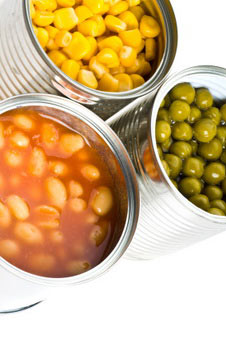Exercise may be tough to fit into a busy day, but outfitting your home gym is easier than you think. You home gym can be as lavish (mega-machines and expensive cardio equipment) or as simple (a good pair of athletic shoes) as you like and, for a budget-minded, it doesn't have to cost a thing.
When I first started working out, I didn't have much of a budget. I was in college and what little money I had went towards food (Ramen noodles) and drink (beer, of course). What I didn't know was that I could've made my own set of weights without spending an extra dime. The nice thing about weight training is that anything with weight will work--a dumbbell, a full water bottle or a sock full of sand...your body doesn't know the difference.
There are plenty of things you probably have in your house right now that could serve as weights--you just need to be a little creative to get started:
Making Your Own Weights
Whether you're outfitting a home gym or traveling, there are a variety of things you can use as dumbbells such as:
- Full Soup Cans. These are great for lighter weights. Some larger cans weigh up to a pound (or more) and could be used for upper body exercises.
- Full Water Bottles. A large water bottle (say around 33.8 fluid ounces) can give you a little more than 2 pounds when full of water. Fill it with sand, rocks or change and you get even more weight.
- Computer Bags or Small duffel bags. My husband carries around a small computer bag so stuffed with crap, it weighs about 10 pounds. Because computer bags usually have handles, these can be great for exercises like bicep curls, lateral raises or one-armed rows. Small duffel bags with handles can be filled with books and used for lower body exercises like squats, lunges and deadlifts.
- Milk or Orange Juice Jugs. Save your old milk jugs and fill them with sand, change or water for weights with ready-made handles
- PVC Pipes. I had one client who filled PVC pipes with sand, capping them off with duct tape to avoid spillage. This is a great idea since PVC pipes come in all shapes and sizes, many of which fit perfectly in your hand.
- Tennis balls and cans. Shawn Keith, certified personal trainer, recommends filling tennis balls and tennis cans with sand or change for some great handheld weights.
Most of these materials can be found around your house or at your local hardware store. If you're not into making weights yourself, there are some other alternatives for finding cheap equipment.
Cheap Exercise Equipment
If you don't mind a little bargain-hunting, you can find cheap exercise equipment in a variety of places such as:
- Garage Sales and Craigslist. Almost always you can find exercise gear at garage sales and on Craigslist, some of it's even worth buying. Pick up the newspaper to find weekend garage sales in your area-- you are guarantee to find something.
- Play it Again Sports. This store buys and sells used (and new) exercise equipment. If you have one in your area, it's worth checking out especially for their dumbbell selection, which is usually pretty good.
- Classified Ads. Americans love to buy things...especially exercise equipment. They also love to sell things...especially exercise equipment they never used. Check your newspaper for cheap gear--you can often find some great deals.
What Not to Skimp On
While it's a fine idea to bargain-hunt, there are a few crucial items you shouldn't skimp on. Learn from my mistakes and make sure you spend good money on:
- Portable CD players or MP3 players. If you're using your walkman for exercise, you'll want something sturdy and waterproof. Make sure you get decent headphones too.
- Heart Rate Monitors. I bought a HRM from Target for about $20. Guess where it is now? In the trash, my friends. I'm not saying they're completely useless but cheaper versions can be bulky, uncomfortable and not terribly accurate. Stick with companies known for quality HRMs like Polar.
- Treadmills, Elliptical Trainers or other cardio equipment. This is definitely one area where you get what you pay for.
- Athletic shoes. Your shoes may be the most important piece of equipment you own--if you don't have supportive shoes that fit right and match your sport, you could have problems with injury or discomfort. Think quality--if your feet don't work right, nothing else will either.
Creating a home gym with little or no money is easy if you're on a budget. Anything with weight can be used for strength training exercises, so don't be afraid to get creative and break the rules a little!
By Paige Waehner, About.com Guide
About.com Health's Disease and Condition content is reviewed by our Medical Review Board


 The food processing world is reeling right now one day after a shocking new series of tests released by Consumer Reports revealed that many leading brands of canned foods contain Bisphenol A (BPA)—a toxic chemical linked to health risks including reproductive abnormalities, neurological effects, heightened risk of breast and prostate cancers, diabetes, heart disease and other serious health problems.
The food processing world is reeling right now one day after a shocking new series of tests released by Consumer Reports revealed that many leading brands of canned foods contain Bisphenol A (BPA)—a toxic chemical linked to health risks including reproductive abnormalities, neurological effects, heightened risk of breast and prostate cancers, diabetes, heart disease and other serious health problems.
